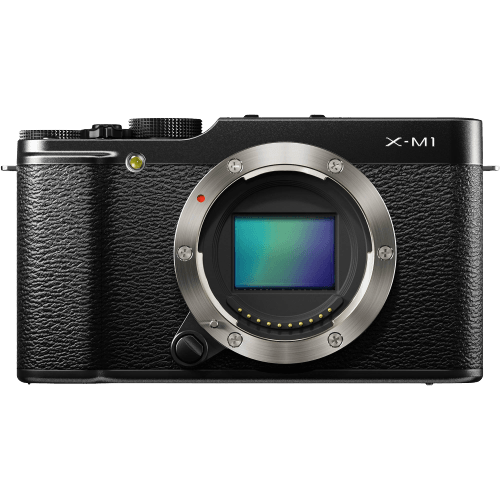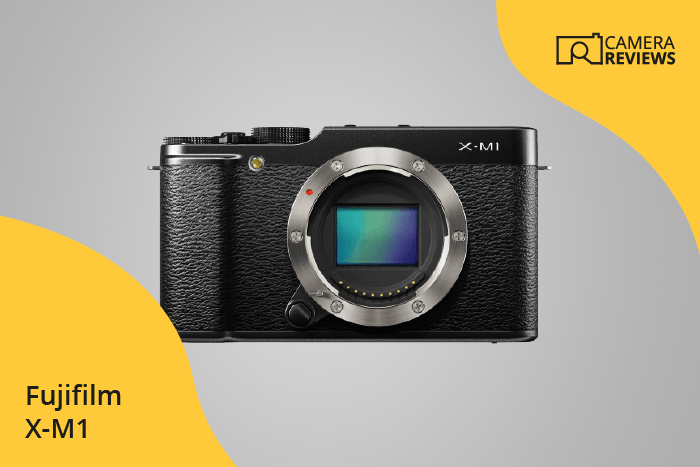Fujifilm X-M1 Specs and Scores

The Fujifilm X-M1 scores a 51 out of 100, which is a modest result for a mirrorless camera. Announced on June 25, 2016, and released the same year, it originally retailed for $700. The X-M1 measures 117 x 67 x 39mm and weighs 330g (0.73lbs), making it a relatively compact and lightweight option. However, considering the advancements in camera technology since 2016, the X-M1’s specifications may not be as competitive in today’s market.
Fujifilm X-M1 Overview and Optics
The Fujifilm X-M1 receives a score of 53/100 for its optics. This camera is equipped with a 16-megapixel APS-C CMOS sensor and is powered by the EXR Processor II. It has a shooting speed of 5.6 frames per second, making it suitable for capturing fast-moving subjects. The Fujifilm X lens mount ensures compatibility with a wide range of lenses, but the absence of image stabilization may require a steady hand or tripod for optimal results. The 3:2 aspect ratio is standard for most cameras and provides a good balance between image width and height.
In the current market, the X-M1’s specifications are modest compared to newer models. While the 16-megapixel sensor still delivers quality images, higher resolution sensors are now available. The shooting speed is acceptable, but not exceptional, and the lack of image stabilization could be a drawback for some users. Despite these limitations, the Fujifilm X-M1 remains a reliable choice for photographers seeking a compact, versatile camera with a solid selection of lenses.
Fujifilm X-M1 Video Performance
The Fujifilm X-M1 holds a video score of 43 out of 100. It offers Full HD video recording with a maximum resolution of 1920 x 1080 pixels. The camera supports a maximum video frame rate of 30fps, which is standard for many cameras in the market. However, it does not include built-in time-lapse functionality, a feature that is becoming increasingly popular among photographers and videographers.
Considering the specifications, the video capabilities of the Fujifilm X-M1 are average when compared to other cameras in today’s market. It provides decent quality for casual video recording but may not be suitable for professionals or those seeking advanced video features. While the camera excels in other areas such as optics and general specifications, its video performance is not its strongest suit.
Fujifilm X-M1 Features and Benefits
The Fujifilm X-M1 scores 54/100 for its features, indicating that it has a moderate range of specifications. With a screen size of 3 inches and a resolution of 920,000 dots, the display is adequately sized and clear. However, the camera does not have a touchscreen, which might be a drawback for some users.
The presence of a flip screen on the X-M1 adds flexibility for various shooting angles. While it lacks GPS, the camera compensates with WIFI and Bluetooth connectivity. These features allow for easy sharing and transferring of images.
Comparing the X-M1 to other cameras in today’s market, its specifications are satisfactory but not outstanding. The lack of a touchscreen and GPS might be dealbreakers for some, but the flip screen and connectivity options make it a viable option for others. Ultimately, the Fujifilm X-M1’s features cater to a specific audience that values certain specifications over others.
Fujifilm X-M1 Storage and Battery
The Fujifilm X-M1 receives a storage and battery score of 21/100. It has a single memory card slot that accepts SD, SDHC, and SDXC cards, with UHS-I compatibility. In today’s market, this may not be enough for users who require multiple card slots and faster memory card options.
The battery life of the X-M1 is 350 shots, which is powered by an NP-W126 battery. This camera does not support USB charging. Compared to modern cameras, the X-M1’s battery life and charging options fall short, as many cameras now offer longer battery life and USB charging capabilities.
The Fujifilm X-M1’s storage and battery features are not competitive in the current market, as they lack multiple card slots, faster memory card compatibility, and convenient charging options.
Fujifilm X-M1 Alternatives
Do you want to know how the Fujifilm X-M1 compares to its competitors? Have a look at the most popular comparisons for this camera below:
- Fujifilm X-M1 vs X-T2
- Fujifilm X-M1 vs X-T5
- Fujifilm X-M1 vs Nikon Z50
- Canon EOS R6 Mark II vs Fujifilm X-M1
- Canon EOS M100 vs Fujifilm X-M1
- Canon EOS M6 Mark II vs Fujifilm X-M1
Fujifilm X-M1 FAQ
Does the Fujifilm X-M1 Have Built-in Image Stabilization?
The Fujifilm X-M1 does not have built-in image stabilization. However, it can utilize lenses with optical image stabilization for improved image quality in challenging lighting conditions.
Does the Fujifilm X-M1 Support 4K Video Recording?
No, the Fujifilm X-M1 does not support 4K video recording. Its maximum video resolution is Full HD 1080p at 30fps, which still provides decent quality for most purposes.
What Size Sensor Does The Fujifilm X-M1 Have?
The Fujifilm X-M1 features an APS-C size sensor, which is a common sensor size for mirrorless and DSLR cameras. This sensor size provides a good balance between image quality and camera size.
Does the Fujifilm X-M1 Have a Dual Memory Card Slot?
No, the Fujifilm X-M1 has a single memory card slot that supports SD, SDHC, and SDXC cards. While this may be limiting for some photographers, it is sufficient for most users.
Does the Fujifilm X-M1 Have a Touch Screen?
No, the Fujifilm X-M1 does not have a touch screen. It features a 3-inch tilting LCD screen for image composition and review, but it lacks touch capabilities.
Does the Fujifilm X-M1 Have Wi-Fi and Bluetooth?
The Fujifilm X-M1 has built-in Wi-Fi for wireless image transfer and remote control. However, it does not have Bluetooth connectivity for additional wireless functionality.
Does the Fujifilm X-M1 Have GPS?
No, the Fujifilm X-M1 does not have built-in GPS functionality. To geotag images, you would need to use an external GPS device or manually add location data during post-processing.
Is the Fujifilm X-M1 Weather Sealed?
No, the Fujifilm X-M1 is not weather sealed. This means that it may not be suitable for use in extreme weather conditions or environments with a high risk of moisture and dust exposure.
Does the Fujifilm X-M1 Have a Built-in Flash?
Yes, the Fujifilm X-M1 has a built-in pop-up flash for added convenience when shooting in low-light situations or when additional fill light is needed.

